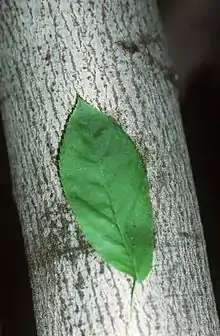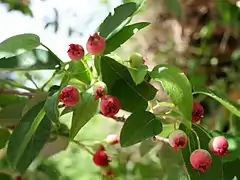Amelanchier laevis
Amelanchier laevis, the smooth shadbush, smooth serviceberry or Allegheny serviceberry, is a North American species of tree in the rose family Rosaceae, growing up to 9 metres (30 ft) tall. It is native to eastern Canada and the eastern United States, from Newfoundland west to Ontario, Minnesota, and Iowa, south as far as Georgia and Alabama.[3]
| Amelanchier laevis | |
|---|---|
 | |
| Leaf and bark | |
| Scientific classification | |
| Kingdom: | Plantae |
| Clade: | Tracheophytes |
| Clade: | Angiosperms |
| Clade: | Eudicots |
| Clade: | Rosids |
| Order: | Rosales |
| Family: | Rosaceae |
| Genus: | Amelanchier |
| Species: | A. laevis |
| Binomial name | |
| Amelanchier laevis | |
| Synonyms[2] | |
|
Synonymy
| |
Description
Amelanchier laevis has stems of 1–15 metres (3 ft 3 in – 49 ft 3 in) or 2–17 metres (6 ft 7 in – 55 ft 9 in) which grow in small clumps. Its petioles are 12–25 millimetres (0.47–0.98 in) with green blades which are elliptic and almost ovate. The leaves have 12–17 lateral veins and 6-8 teeth per cm. The white blossoms, which can be spectacular in mature specimens, develop from pink buds in spring. The fruit, which are pomes, ripen in autumn. They are edible and can be eaten raw or cooked. The fruit has a sweet flavor. The bark can be made into a herbal medicine for expectant mothers. It is a deciduous tree hardy in zones 4 to 8.[4] It is cultivated as an ornamental shrub.[5][6][7]
The cultivar 'R.J. Hilton', with richer spring and autumn leaf color than the species, has gained the Royal Horticultural Society's Award of Garden Merit.[8][9]
References
- Botanic Gardens Conservation International (BGCI). & IUCN SSC Global Tree Specialist Group. (2018). "Amelanchier laevis". The IUCN Red List of Threatened Species. IUCN. 208. e.T135956199A135956201. doi:10.2305/IUCN.UK.2018-2.RLTS.T135956199A135956201.en. S2CID 242098459.
- The Plant List, Amelanchier laevis Wiegand
- Biota of North America Program 2014 state-level distribution map
- "Kentucky Cooperative Extension". Department of Horticulture. Retrieved 11 June 2019.
- "Amelanchier laevis". University of Maine. Archived from the original on June 26, 2010. Retrieved February 10, 2008.
- Wiegand, Karl McKay 1912. Rhodora 14(163): 154–158 diagnosis in Latin, description and commentary in English
- Wiegand, Karl McKay 1912. Rhodora 14(163): plate 96, figures 7A-7G line drawings of leaves, fruits, and flowers of Amelanchier laevis
- "Amelanchier laevis 'R.J. Hilton'". www.rhs.org. Royal Horticultural Society. Retrieved 27 February 2020.
- "Award of Garden Merit Plants November 2018 - Ornamentals" (PDF). Royal Horticultural Society. 2018. Retrieved 2019-03-27.

.jpg.webp)
